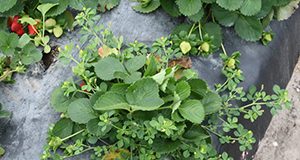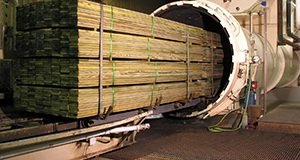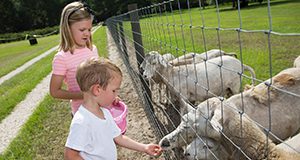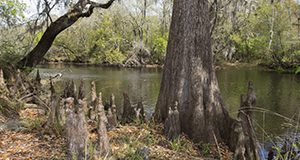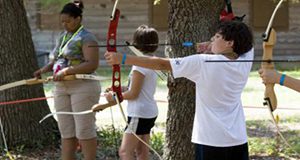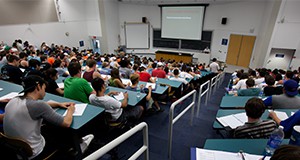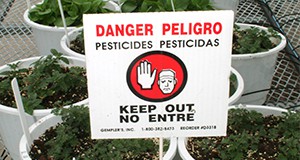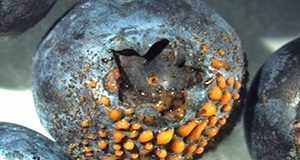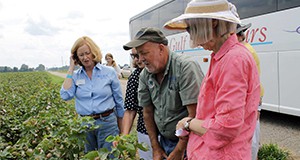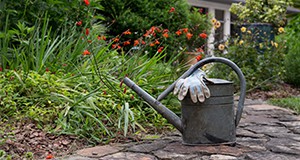This 5-page document is one in the Key Plant, Key Pests series. It helps identify common pests found on the Chinese elm (Ulmus parvifolia). Written by Juanita Popenoe, Caroline R. Warwick, and Richard Beeson Jr. and published by the UF/IFAS Environmental Horticulture Department, July 2018.
https://edis.ifas.ufl.edu/ep559
Author: Sarah Chrisien
Control of Black Medic in Strawberry Production
Black medic is an annual broadleaf weed that competes with strawberry crops and impedes harvest. This 4-page document describes how to manage black medic in strawberry production. Written by Shaun M. Sharpe and Nathan S. Boyd and published by the UF/IFAS Horticultural Sciences Department, July 2018.
https://edis.ifas.ufl.edu/hs1319
Wood Preservatives
This 6-page document describes the purpose of applying preservatives to various wood products. A description of wood preservatives registered for use in Florida is also provided. Written by Frederick M. Fishel and published by the UF/IFAS Agronomy Department, July 2018.
https://edis.ifas.ufl.edu/pi276
Key Plant, Key Pests: Crapemyrtle (Lagerstroemia)
This 4-page document is one in the Key Plant, Key Pests series. It helps identify pests found on the crapemyrtle, one of the most common landscape plants in north and central Florida. Written by Juanita Popenoe, Caroline R. Warwick, and Chris Marble and published by the UF/IFAS Environmental Horticulture Department, June 2018.
http://edis.ifas.ufl.edu/ep560
Packaging and Storage of Hops (Humulus lupulus)
Hops (Humulus lupulus) are an essential ingredient to the production of beer. This 3-page document describes how to properly store and package hops. Written by Brian Pearson and Sean Campbell and published by the UF/IFAS Environmental Horticulture Department, June 2018.
http://edis.ifas.ufl.edu/ep561
Helping Agritourism Visitors Learn During Their Visits
Agritourism is a growing industry in Florida, and combines two of the state’s major assets: tourism and agriculture. This 4-page document outlines ways that agritourism operators can incorporate meaningful educational opportunities into their operation. Written by Kathryn Stofer and Joy N. Rumble and published by the UF/IFAS Department of Agricultural Education and Communication, June 2018.
http://edis.ifas.ufl.edu/wc308
Key Plant, Key Pests: Camellia
This 7-page document is one in the Key Plant, Key Pests series. It discusses identification and management of pests found on the camellia, a flowering plant common in Southern landscapes. Written by Juanita Popenoe, Caroline R. Warwick, and Brian Pearson and published by the UF/IFAS Environmental Horticulture Department, June 2018.
http://edis.ifas.ufl.edu/ep558
Key Plant, Key Pests: Baldcypress (Taxodium distichum)
This 4-page document is one in the Key Plant, Key Pests series. It provides information on the management of common pests found on baldcypress. Written by Juanita Popenoe, Caroline R. Warwick, and Roger Kjelgren and published by the UF/IFAS Environmental Horticulture Department, June 2018.
http://edis.ifas.ufl.edu/ep557
Teaching for Extrinsic Motivation

Motivation is the idea of being moved to do something, and levels of motivation vary among every individual. Extrinsic motivation is a specific type of motivation that is fueled by external rewards or an expected outcome. This 2-page document, written by Isabella Damiani, Andrew Thoron, and J. C. Bunch and published by the UF/IFAS Department of Agricultural Education and Communication, discusses how educators can foster extrinsic motivation among their students.
http://edis.ifas.ufl.edu/wc307
Selecting Educational Resources
Many instructors struggle to find appropriate educational resources. However, collaborative teaching and learning efforts have created a number of educational resources that can be stored, shared, adapted, and used within the agricultural education profession. This 7-page document will help educators in selecting educational resources. Written by Tyler D’Angelo, Deb Barry, J. C. Bunch, and Andrew Thoron and published by the UF/IFAS Department of Agricultural Education and Communication, June 2018.
http://edis.ifas.ufl.edu/wc303
Florida-Friendly Landscaping Guidelines for Community Associations: Considerations for Selecting a Landscape Contractor and Writing an Effective Landscaping Contract
Florida-Friendly Landscaping protects Florida’s unique natural resources by conserving water, reducing waste and pollution, creating wildlife habitat, and preventing erosion. This 12-page document will help the reader with selecting and writing a landscape contract that follows Florida-Friendly Landscaping principles. Written by Adam Dale, Claire Lewis, Esen Momol, Don Rainey, John Bossart, C. J. Bain, Jen Marvin, Lynn Barber, Norman Leppla, Gary Knox, and Thomas T. Ankerson and published by the UF/IFAS Environmental Horticulture Department, June 2018.
http://edis.ifas.ufl.edu/ep347
Risk Management for 4-H Youth Development Work: Shooting Sports State Plan and Program Guidelines
This 4-page publication is one in the series Risk Management for 4-H Youth Development Work. It discusses the 4-H Shooting Sports Program, which teaches young people the safe and responsible use of firearms, principles of archery, and hunting basics. Written by Jerry Culen, Dale Pracht, Paula Davis, Stefanie Prevatt, and Janet Psikogios and published by the UF/IFAS 4-H Youth Development Department, June 2018.
http://edis.ifas.ufl.edu/4h390
Teaching and Learning: Motivating Learners
Motivation is a process that drives individuals forward. Educators must be aware of the continuum of motivation and appropriately provide opportunities for student engagement, learning, and growth. This 2-page document discusses how to motivate learners. Written by Isabella Damiani, Andrew Thoron, and J. C. Bunch and published by the UF/IFAS Department of Agricultural Education and Communication, May 2018.
http://edis.ifas.ufl.edu/wc305
Utilizing Demonstrations in Teaching, with An Example Demonstration of Plant Propagation via Cuttings
In a learning environment, it is important to provide instruction to each type of learner. This 4-page document discusses utilizing demonstrations for different types of learners and includes a sample demonstration of plant propagation. Written by Isabella Damiani, Andrew Thoron, and J. C. Bunch and published by the UF/IFAS Department of Agricultural Education and Communication, May 2018.
http://edis.ifas.ufl.edu/wc306
Specifically Regulated Pesticides in Florida-Bromacil
Bromacil is a general use pesticide that is marketed in Florida under many names and is used on sites such as citrus, pineapple, and industrial areas. This 2-page document discusses the characteristics and use of bromacil. Written by Frederick M. Fishel and published by the UF/IFAS Agronomy Department, May 2018.
http://edis.ifas.ufl.edu/pi112
Anthracnose on Southern Highbush Blueberry
Information contained in this 4-page publication is intended for Florida blueberry growers to use as a guide in the identification of anthracnose, a group of fungal pathogens that affects a wide range of plants, including southern highbush blueberries (SHB). Written by Douglas A. Phillips, Maria C. Velez-Climent, Philip F. Harmon, and Patricio R. Munoz and published by the UF/IFAS Plant Pathology Department, May 2018.
http://edis.ifas.ufl.edu/pp337
Selecting the Right Type of Educational Experience for Your Agritourism Operation
Agritourism has become a way for consumers to experience agriculture and for the industry to increase agricultural awareness. This 4-page document will help guide you toward selecting the right type of educational experience for your agritourism operation. Written by Joy N. Rumble, Kathryn Stofer, and Hoda Manafian Ghahfarokhi and published by the UF/IFAS Department of Agricultural Education and Communication, May 2018.
http://edis.ifas.ufl.edu/wc304
Seed Piece Spacing Adjustment for Florida Chipping Potato
Seed spacing directly affects crop revenue because the number of potato seeds planted determines the final plant population density. The analysis presented in this 5-page publication was extracted from a series of field trials that looked at improved potato plant arrangement in the field by adjusting seed piece spacing for Florida growing conditions. Written by Fernanda Souza Krupek, Steven A. Sargent, Peter J. Dittmar, and Lincoln Zotarelli and published by the UF/IFAS Horticultural Sciences Department, May 2018.
http://edis.ifas.ufl.edu/hs1317
Biology and Management of Dodder (Cuscuta spp.) in Ornamental Crop Production and Landscape
Dodder are a group of over 150 species in the genus Cuscuta. This 4-page publication was developed to help commercial growers, landscape professionals, and homeowners identify and manage dodder infestations in their greenhouses, nurseries, or landscapes. Written by Kaley Mierek, Chris Marble, Nathan Boyd, and Shawn Steed and published by the UF/IFAS Environmental Horticulture Department, May 2018.
http://edis.ifas.ufl.edu/ep556
Using Perceived Landscape Benefits to Subgroup Extension Clients to Promote Urban Landscape Water Conservation
Because a large percentage of water used in urban areas can be applied through irrigation, home landscape management practices are an important factor of water conservation. The information in this 5-page document is the result of a cluster analysis used to identify meaningful subgroups among home irrigation users to encourage water conservation behaviors. Written by Amanda D. Ali, Laura A. Sanagorski Warner, and Anil Kumar Chaudhary and published by the UF/IFAS Department of Agricultural Education and Communication, May 2018.
http://edis.ifas.ufl.edu/wc291

